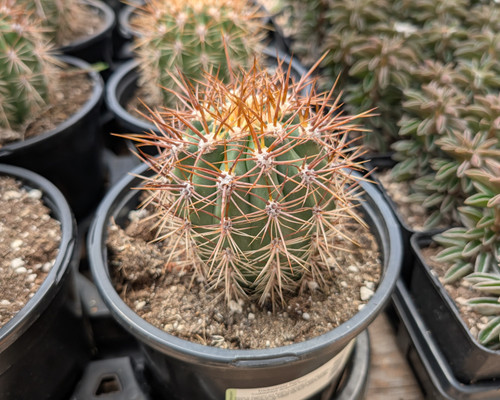Pot Size: 1 gal
Accepted Scientific Name:
Trichocereus pasacana
Origin and Habitat:
Trichocereus pasacana is native to the high-altitude regions of northwestern Argentina, southern Bolivia, and northern Chile. It grows on rocky slopes and arid hillsides in the Andes, often at elevations between 2,000 and 3,500 meters. The climate in this region is dry with intense sunlight, low humidity, and significant temperature fluctuations between day and night. This environment has shaped the plant’s slow-growing, drought-tolerant nature and its ability to withstand cold temperatures and high UV exposure.
Description:
Trichocereus pasacana is a large, columnar cactus that can grow over 10 feet (120 inches) tall in cultivation, though much taller in its native habitat. It forms thick, upright stems up to 12 inches in diameter, with 10–20 ribs and dense, golden to brown spines that may grow up to 4 inches long. The cactus produces large, funnel-shaped, white flowers near the top of the stems, typically blooming at night and measuring 6–8 inches across. Flowers are often followed by spiny, fleshy fruits.
Cultivation:
Zone: Suitable for USDA Zones 8–11, or indoors in colder climates.
Temperature: Hardy down to approximately -6°C when dry; optimal range is 15–30°C.
Growth Rate: Very slow-growing, especially in cooler climates.
Soil: Use a well-draining mix with plenty of pumice to ensure aeration and prevent rot.
Watering: Water deeply but infrequently during the growing season; keep dry in winter.
Fertilizing: Feed with a low-nitrogen cactus fertilizer every 2–3 weeks during spring and summer.
Light: Requires full sun to thrive; insufficient light will lead to weak, elongated growth.
Pests and Diseases: Generally pest-resistant but may suffer from scale, mealybugs, or root rot if overwatered or poorly drained.
Propagation:
Propagation is typically done by seed, as cuttings are difficult due to the plant’s size and slow growth. Sow seeds in well-draining pumice-based soil and keep warm and lightly moist until germination.







